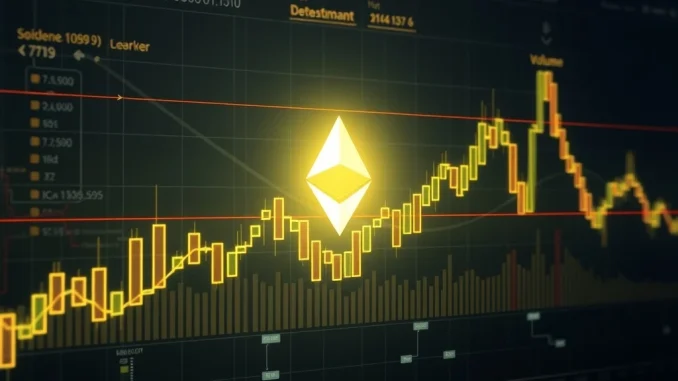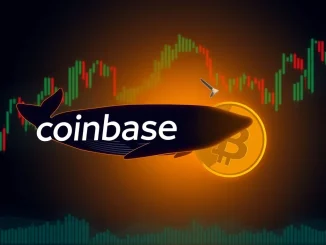
The crypto market is a dynamic beast, and today, all eyes are on the Ethereum price. After a recent sharp pullback from highs near $3,860, ETH finds itself in a period of cautious consolidation, hovering below key resistance levels. What’s driving this pause, and what does it mean for investors and traders? Let’s dive deep into the latest market data and technical insights to uncover the potential path forward for the world’s second-largest cryptocurrency.
Ethereum Price Action: A Closer Look at Current Trends
As of July 25, 2025, Ethereum’s price action reflects a market grappling with uncertainty. ETH is currently stabilizing near $3,640, following a breakdown from an ascending channel that had previously supported its rally since mid-July. This consolidation below the crucial $3,708 mark indicates a battle between buyers and sellers, with neither side currently asserting clear dominance.
- The 1-hour Relative Strength Index (RSI) sits at 50.40, signaling a neutral stance with no immediate bullish or bearish reversal confirmed.
- A critical resistance zone has emerged around the weekly Fibonacci 0.786 retracement level of $3,525. A decisive reclamation of this threshold is essential to alleviate further downward pressure.
Decoding Crypto Derivatives Volume: What the Data Reveals
The derivatives market often provides a clearer picture of institutional and large-scale trader sentiment. Recent data from Coinglass underscores a cautious outlook, with significant declines in key metrics:
- Derivatives Volume Drop: Ethereum’s derivatives volume has fallen by 13.55% to $120.30 billion, indicating reduced trading activity and potentially lower conviction among participants.
- Open Interest Decline: Alongside volume, open interest (the total number of outstanding derivatives contracts) has declined by 4.04% to $54.27 billion. This suggests that fewer new positions are being opened, and some existing ones are being closed.
- Options Trading Volume: A 25% drop in options trading volume further highlights a reduction in speculative activity, as traders become less willing to bet on large price swings.
Despite these declines, the long/short ratios on major exchanges remain above 1.6, implying that a lingering bullish expectation still exists among some market participants. This divergence between declining activity and persistent bullish bias creates a complex scenario for the immediate Ethereum price trajectory.
Unpacking Ethereum Technical Analysis: Indicators and Patterns
Technical indicators offer crucial insights into Ethereum’s current state and potential future movements:
- Symmetrical Triangle Formation: On the 30-minute timeframe, ETH is forming a symmetrical triangle pattern between $3,560 and $3,700. This pattern typically precedes a breakout, but its direction is currently ambiguous.
- Bearish Bias Indicators: A bearish sentiment persists, as the Parabolic SAR (Stop and Reverse) remains above the price, signaling potential downward momentum. Additionally, the Supertrend indicator flipped red below $3,740, reinforcing a cautious outlook.
- Bollinger Bands Compression: The 4-hour chart reveals compressing Bollinger Bands, with ETH hugging the midline between the 50-period Exponential Moving Average (EMA) at $3,545 and the upper band at $3,708. The 20 EMA is currently at $3,669. This compression often precedes a significant volatility spike in the next 24 hours.
- Volume Profile Data: Analysts note a key Point of Control (POC) at $3,299, representing a high-volume node where significant trading activity occurred. A critical rejection zone is also identified near $3,800–$3,860, indicating strong selling pressure at those levels.
- Other Indicators: The Moving Average Convergence Divergence (MACD) shows a weak crossover, suggesting indecisiveness, while the Average Directional Index (ADX) flattening on the Directional Movement Index (DMI) points towards consolidation rather than a strong trending structure.
Navigating ETH Price Prediction: Key Levels to Watch
Understanding critical support and resistance levels is paramount for any investor seeking to navigate the current market conditions. Here’s a breakdown of the key price points for Ethereum as of July 25, 2025:
| Level/Indicator | Value/Signal | Significance |
|---|---|---|
| Immediate Resistance | $3,708 | A breakout above this level is crucial for bullish momentum. |
| Next Resistance | $3,830 | Potential target after clearing immediate resistance. |
| Strong Resistance | $4,000 | Key psychological and technical barrier. |
| Immediate Support | $3,545 | (50 EMA on 4-hour chart) Critical level to hold. |
| Key Support | $3,500 | A breakdown here could trigger further declines. |
| Confluence Support | $3,300 | (100 EMA & high-volume node) Strong defense zone. |
| 1-Hour RSI | 50.40 | Neutral, indicating no clear directional bias. |
| MACD | Weak crossover | Indecisive market sentiment. |
| Bollinger Bands | Compressing | Suggests potential volatility spike ahead. |
| Open Interest | $54.27B (Declining) | Reduced market participation and new positions. |
A successful breakout above $3,708 could potentially push ETH towards $3,830 and then $4,000. Conversely, if the price remains range-bound or fails to hold support, a retest of $3,545 and $3,500 is expected. A breakdown below $3,500 could target $3,300, where significant confluence support exists.
What Does ETH Consolidation Mean for Investors?
The current period of ETH consolidation signals a moment of indecision in the market. While the higher timeframe trend for Ethereum remains broadly bullish, near-term momentum hinges on a decisive move. Investors should pay close attention to the aforementioned key levels.
- A strong break above $3,700, ideally with increased volume, would suggest renewed bullish strength.
- Conversely, a sustained break below $3,545 could indicate a deeper correction is underway.
The flattening ADX and weak MACD crossover reinforce that the market is currently in a non-trending phase. This environment often favors range-bound trading strategies or waiting for a clear breakout/breakdown confirmation before making significant moves. Vigilance and a clear understanding of these technical and derivatives signals are paramount for navigating the evolving landscape of the Ethereum price.
Conclusion
Ethereum is currently navigating a critical phase of consolidation, marked by declining derivatives volume and open interest, alongside mixed technical signals. While lingering bullish expectations exist, the immediate future of the Ethereum price depends on its ability to decisively break out of its current range. Traders and investors should closely monitor the key resistance at $3,708 and support at $3,545 to anticipate the next significant move. As the market digests recent shifts, patience and informed decision-making will be key to capitalizing on Ethereum’s next trajectory.
Frequently Asked Questions (FAQs)
Q1: Why is Ethereum consolidating below $3,708?
A1: Ethereum is consolidating due to a sharp pullback from higher levels and a breakdown from an ascending channel. This indicates a balance between buying and selling pressure, leading to a period of indecision and range-bound movement as the market seeks a new direction.
Q2: What do the declining derivatives volumes and open interest indicate for ETH?
A2: Declining derivatives volume and open interest suggest reduced trading activity and a decrease in the total number of outstanding contracts. This generally indicates lower speculative interest and conviction in the market, pointing towards a cautious sentiment among traders.
Q3: What are the critical resistance and support levels for Ethereum’s price?
A3: Immediate resistance is at $3,708, with further targets at $3,830 and $4,000. Key support levels are at $3,545 (50 EMA) and $3,500. A crucial confluence support level exists at $3,300 (100 EMA and high-volume node).
Q4: Is the overall trend for Ethereum still bullish despite the current consolidation?
A4: Yes, the higher timeframe trend for Ethereum remains broadly bullish. However, the near-term momentum is uncertain, depending on whether ETH can decisively break above $3,700 or falls below $3,545. The current consolidation is a short-term phase within a larger trend.
Q5: What is a symmetrical triangle pattern in crypto charting?
A5: A symmetrical triangle is a chart pattern characterized by converging trend lines, indicating a period of consolidation before a potential breakout. The direction of the breakout is not predetermined, but it often leads to a significant price move once the pattern is resolved.
Q6: How does Bollinger Band compression affect Ethereum’s price?
A6: Bollinger Band compression, where the upper and lower bands narrow, indicates decreasing volatility. This phase is often followed by a period of increased volatility and a significant price move, as the market prepares for a breakout from its tight trading range.



